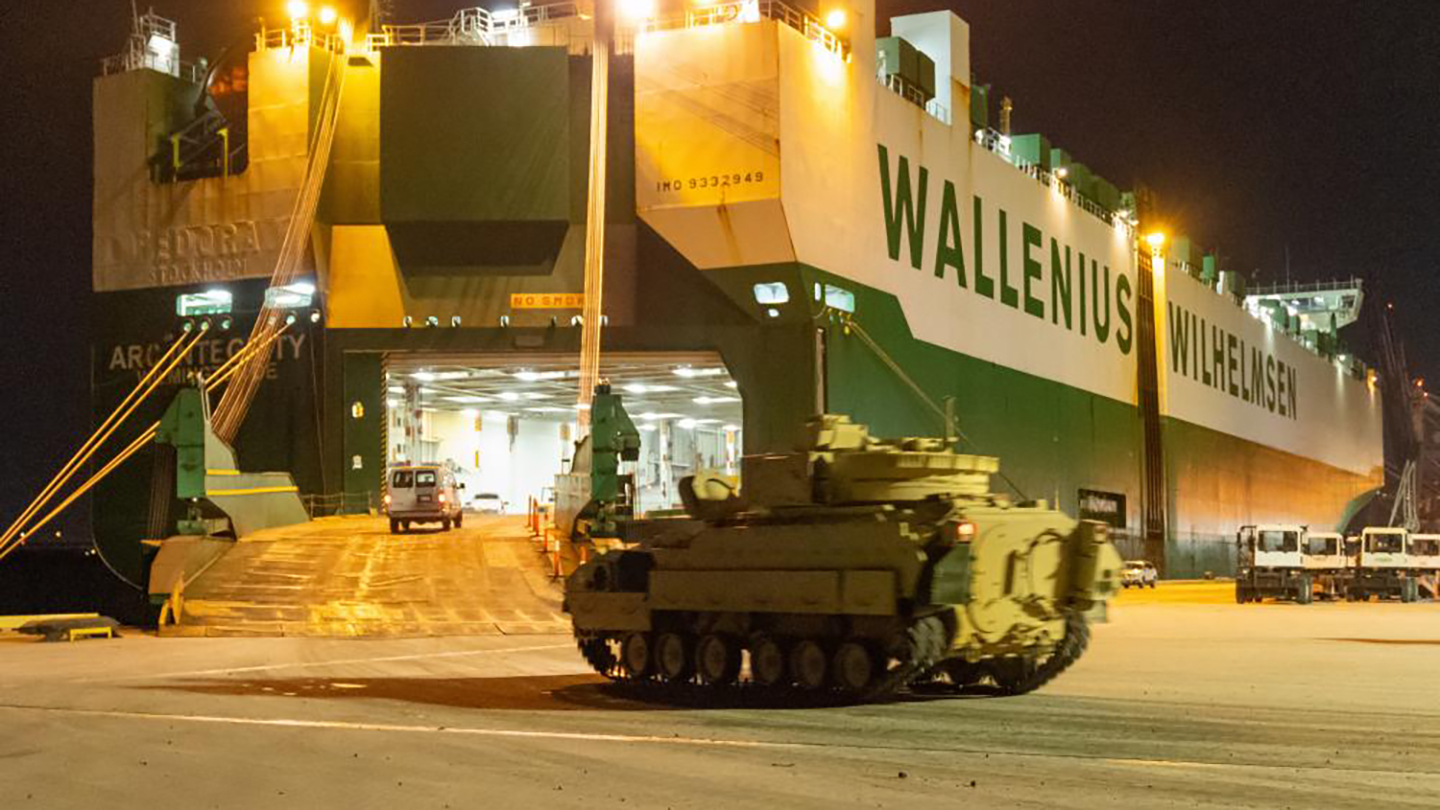The first shipment of more than 60 Bradley M2A2-ODS Fighting Vehicles promised to Ukraine has left port, according to U.S. Transportation Command.
The shipment “left the shores of North Charleston, South Carolina, last week, and will provide the Ukrainian forces with additional offensive and defensive capabilities to protect their borders against Russia’s illegal invasion,” the command – responsible for shipping U.S. military supplies and personnel around the world – said Monday on its homepage.
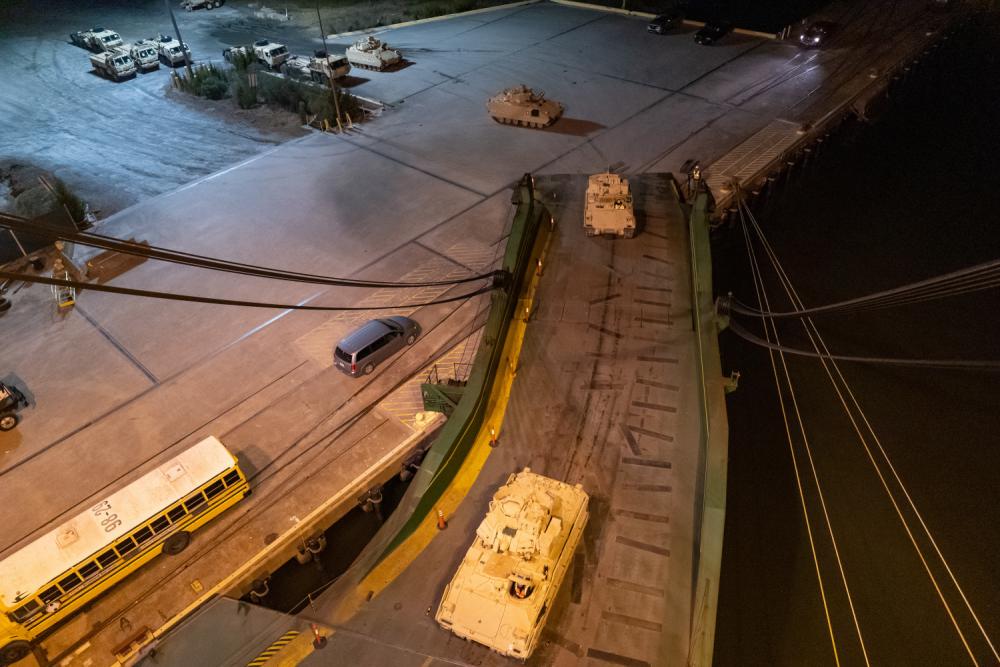
The first batch of a total of 109 Bradleys promised to Ukraine was loaded onto the ARC Integrity roll-on roll-off (RORO) cargo vessel Jan. 25 at the Transportation Core Dock in North Charleston, South Carolina, according to the Defense Department’s Defense Visual Information Distribution Service. The ARC Integrity is a roll-on roll-off cargo vessel owned by ARC Shipping and contracted by TRANSCOM.
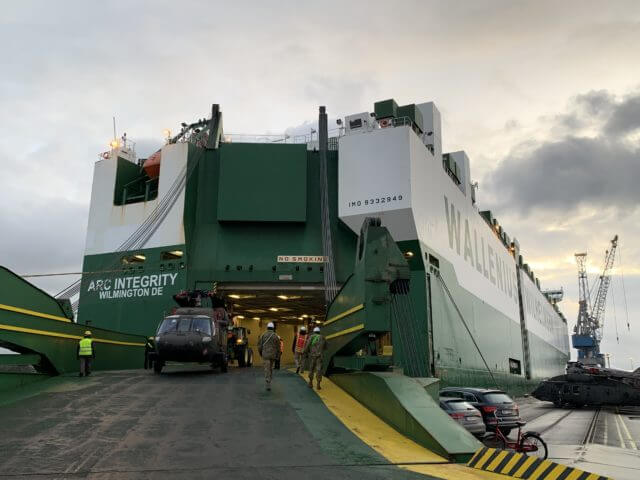
TRANSCOM did not say when Bradleys would arrive in Ukraine. We reached out for more details and will update this story with any information it provides.
“The situation in Ukraine really brought to the forefront the importance of logistics and the complexity of power projection and sustainment,” said Air Force Gen. Jacqueline Van Ovost, USTRANSCOM commander, during an interview with Joint Force Quarterly.
“Our support to Ukraine would not be possible without the strong relationships we have with our allies and partners that provided the access, basing, and overflight to facilitate the delivery of aid,” she added.
On Jan. 5, President Joe Biden announced that Bradley M2A2-OSD would be sent to Ukraine. There were 50 in that first tranche, as part of a $2.85 billion Presidential Drawndown Authorization, according to the Pentagon. On Jan. 19, the Pentagon announced that 59 additional M2A2-ODS vehicles were headed to Ukraine as part of a newer $2.5 billion Presidential Drawdown Authorization.
While more than half the Bradleys promised to Ukraine have been shipped out, it will still be a while before they get into the fight.
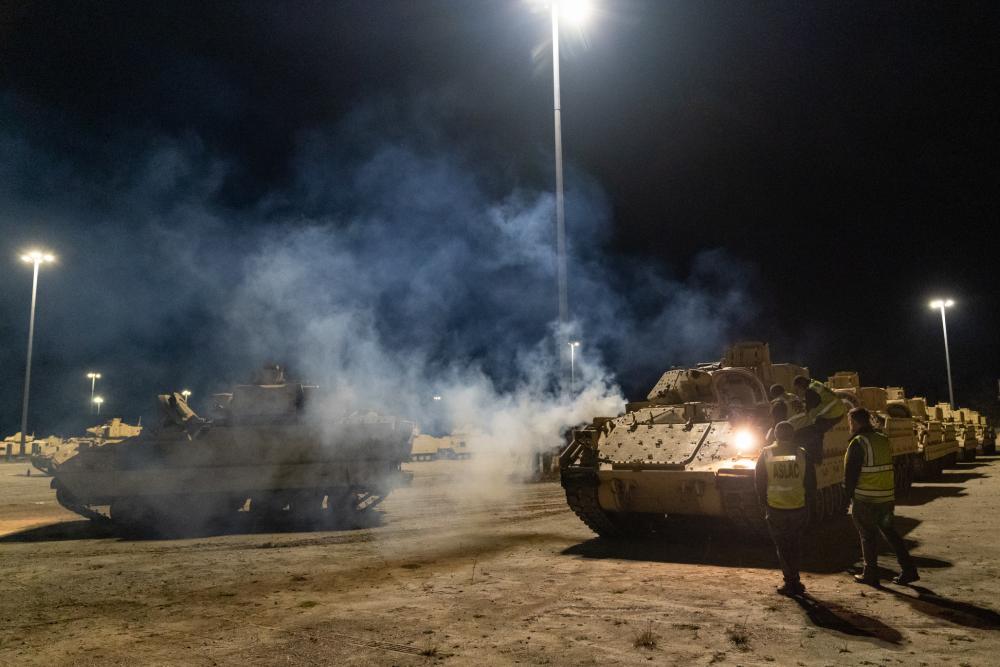
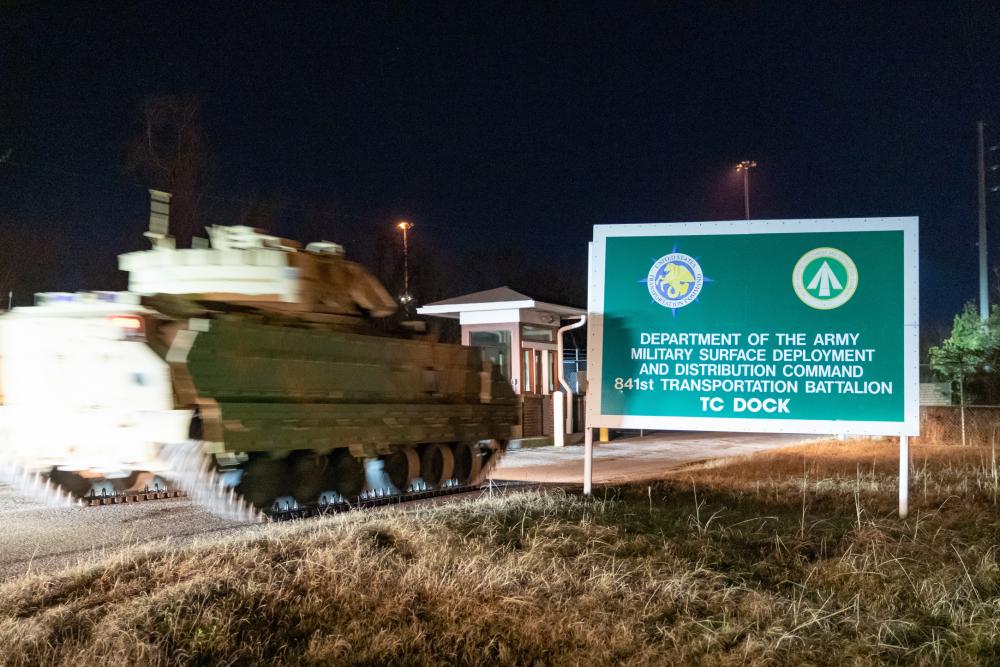
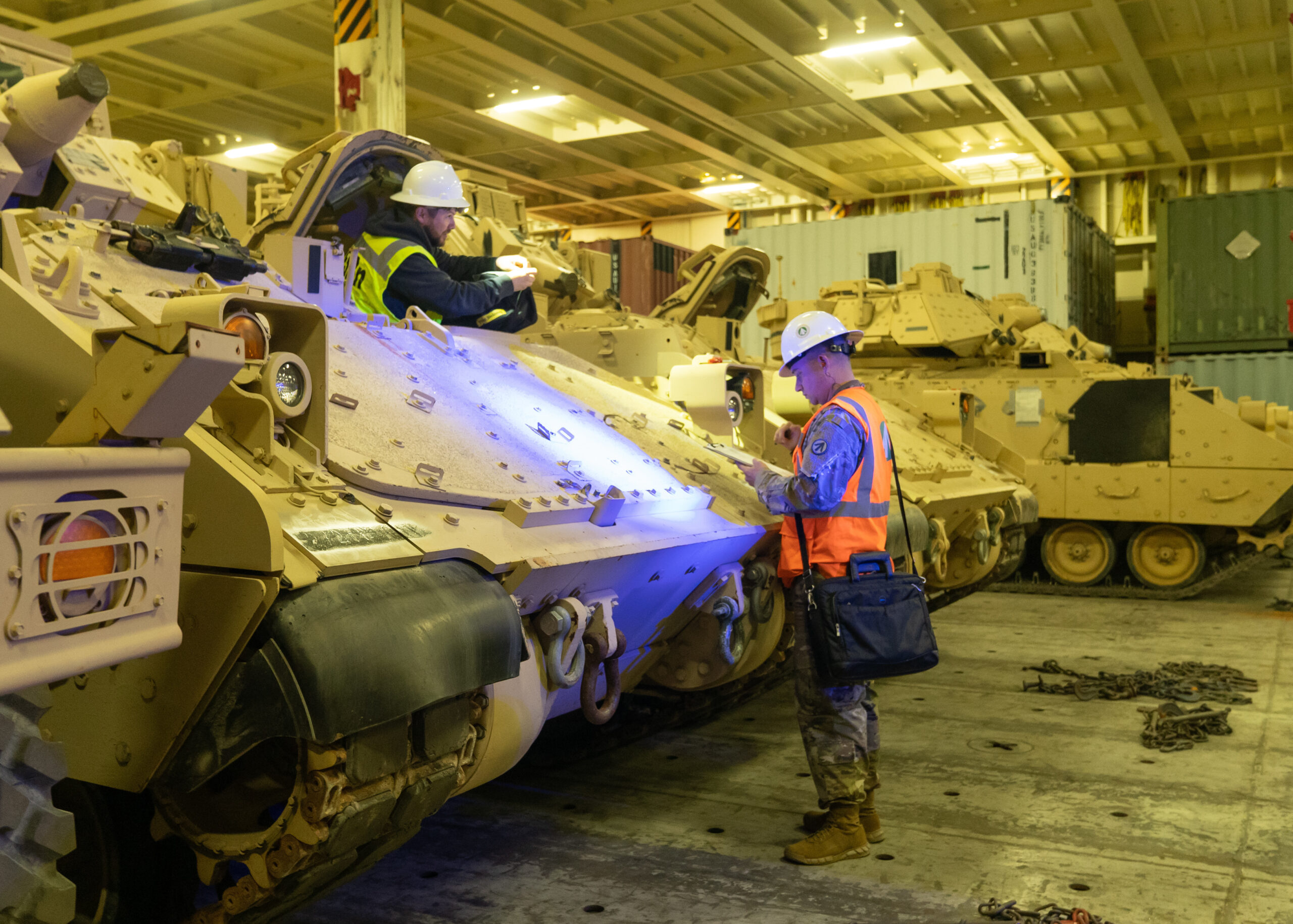
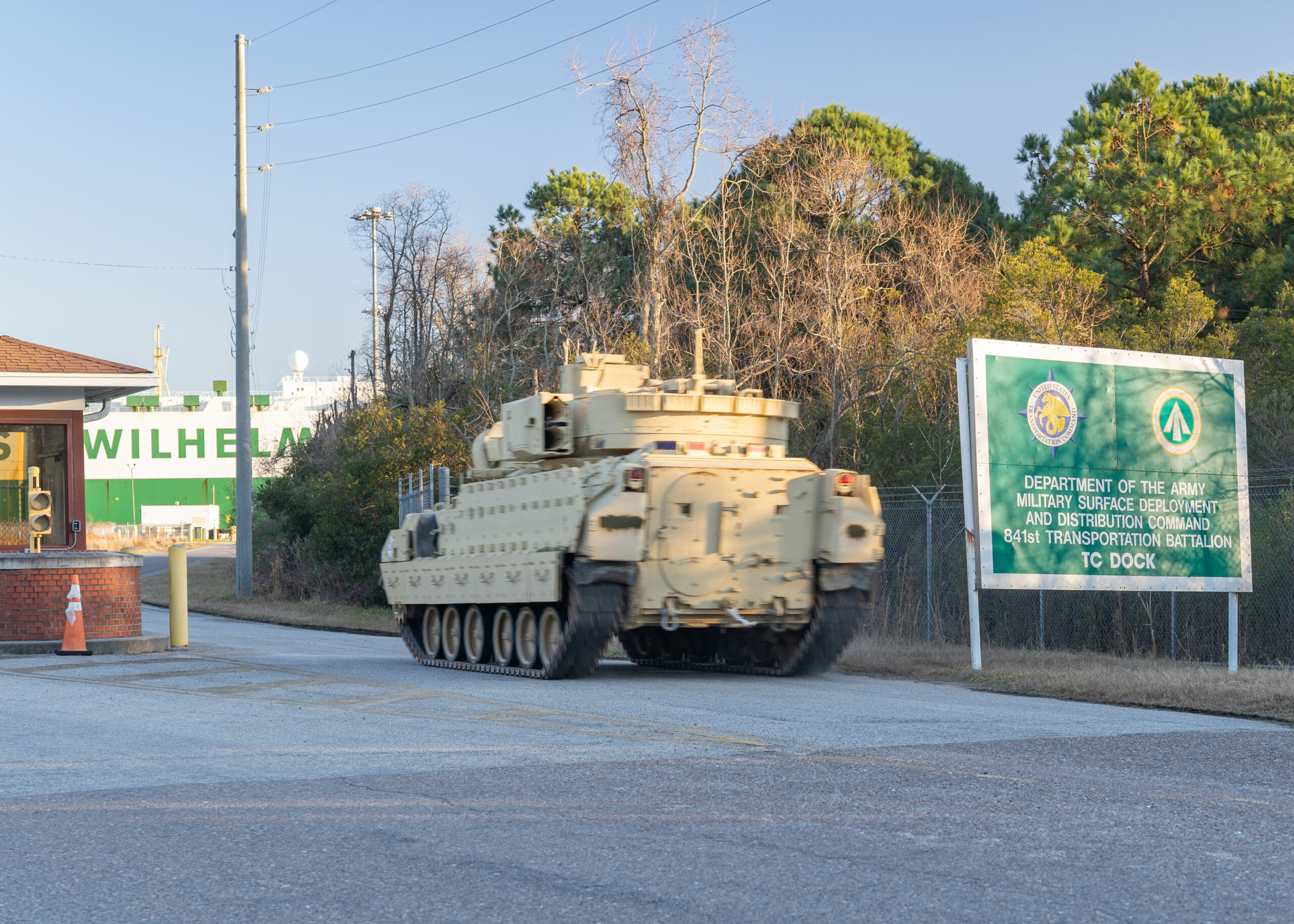

First, they have to get to a seaport and then be shipped, most likely by rail, to a location closer to Ukraine’s border.
It is unclear at the moment whether these vehicles will go to Germany, where Ukrainian troops are already undergoing maneuver warfare training, or directly to Ukraine, most likely through Poland or Romania.
“As we speak, troops are being linked up with Bradley infantry fighting vehicles,” Defense Secretary Lloyd Austin told reporters on Jan. 20 after the wrap-up of the eighth Ukraine Defense Contact Group meeting of some 50 nations working to arm Ukraine in its fight against Russia. “They’ll train for weeks not only on just how to operate the vehicles, but also on how to properly set conditions for maneuver, and then maneuver, and then, you know, how to exploit opportunities, how to breach obstacles.”
For the Ukrainians, the Bradleys, which will greatly aid their combined arms maneuver efforts, can’t arrive on the battlefield soon enough. They are bogged down along much of the front lines – with particularly fierce fighting in the Donbas and both sides eyeing offensives in the coming weeks and months.
One Bradley expert we spoke with said the vehicle’s firepower, maneuverability, and durability are exactly what Ukraine needs as it contemplates further offensives against a foe that still has a sizeable amount of Soviet-era tanks and other armor, as well as its more modern vehicles. You can read more about what the Bradley can provide to Ukraine here.
Before we head into the latest news from Ukraine, The War Zone readers can get caught up with our previous rolling coverage here.
The Latest
On the battlefield, as has been the case for a while, the most intense fighting is in the Donetsk and Luhansk oblasts, while Russian efforts to make a push in Zaporizhzhia Oblast may have stalled. Here are some key takeaways from the latest Institute for the Study of War assessment:
- Russian sources claimed that Ukrainian forces continued counteroffensives in the vicinity of Kuzemivka (about 10 miles northwest of Svatove).
- Ukrainian officials reported that Ukrainian forces continued to repel limited Russian counterattacks west and south of Kreminna.
- Wagner Group financier Yevgeny Prigozhin announced that Wagner forces seized Blahodatne (about 7.5 miles northeast of Bakhmut) on Jan. 29.
- Russian forces continued to conduct ground attacks in the Bakhmut and Donetsk City-Avdiivka areas.
- Ukrainian officials reported that Ukrainian forces repelled assaults near Pobieda (about 2.5 miles southeast of Donetsk City) and Vuhledar. Russian sources claimed that fighting is ongoing to the west and east of Vuhledar.
- Russian sources did not report on any Russian ground attacks in Zaporizhia Oblast for the third consecutive day on Jan. 29. Ukrainian forces conducted a HIMARS strike against a bridge in Svitlodolynske (about 12.4 miles northeast of Melitopol).
- Russian forces continued to conduct routine fire against Kherson City and other settlements in the west (right) bank of the Dnipro River. Kherson Oblast Administration Advisor Serhiy Khlan reported that Russian forces used incendiary munitions to fire on Beryslav.
- Russian authorities are continuing to set conditions for a second wave of mobilization. Head of the State Duma Committee on Defense Andrey Kartapolov stated on Jan. 28 that the committee is reviewing over 20 laws regarding mobilization deferrals.
- The Ukrainian General Staff reiterated that it has not observed Russian forces in Belarus forming a strike group as of Jan. 29.
As the war in Ukraine grinds on and both sides face arms and ammunition shortages, the Secretary General of NATO on Monday urged South Korea to reconsider its ban on providing weapons directly to Ukraine.
“I urge the Republic of Korea to continue and to step up on on the specific issue of military support” to Ukraine, Jens Stoltenberg told reporters Monday at the CHEY Institute during his visit to the Republic of Korea (ROK).

The ROK has provided non-lethal aid to Ukraine, but its current laws prevent it from directly arming combatants in a war. Seoul, has, however, provided 155mm howitzer shells to the U.S. that would ultimately be shipped to Ukraine.
Stoltenberg was asking ROK to reconsider its past opposition to directly arming Ukraine. Other nations, like NATO members Germany and Norway as well as Sweden, have waived similar preclusions.
“I would say that’s at the end of the day, a decision for you to make,” he said. “But I will say that several NATO allies – who had as a policy never to export weapons to two countries in conflict – have changed that policy now.”
Those countries changed their policy, said Stoltenberg, “because they realize that when you are faced with a brutal invasion, where a big power Russia invades another one, in a blatant way, as we have seen in Ukraine, if you believe in freedom, if you believe in democracy, if you don’t want autocracy and tyranny to win, then they need weapons.”
ROK has a large defense industrial base and is becoming a major arms exporter to Europe. In July, it signed its biggest arms export deal ever, agreeing to sell Poland 180 K2 tanks, 48 FA-50 light fighter jets, and about 670 K9 self-propelled artillery pieces.

When asked how and when this full-on war would end, Stoltenberg said the answer is unknown, but Russia is gearing up for a long fight.
“We see that they are preparing for more war, that they are mobilizing more soldiers, more than 200,000, and potentially even more than that,” he said of the Russians. “They are actively acquiring new weapons, more ammunition, ramping up their own production, but also acquiring more weapons from other authoritarian states like Iran and North Korea. And most of all, we have seen no sign that President Putin has changed his overall goal of this invasion that is to control a neighbor, to control Ukraine. So as long as this is the case, we need to be prepared for [the] long haul.”
A day earlier, after a meeting with ROK Foreign Minister Park Jin, Stoltenberg was more specific about how he believed North Korea was arming Russia.
“North Korea is providing military support to the Russian war efforts with rockets and missiles,” he said. “And this just highlights how we are interconnected. We strongly believe that we can do more together in areas like cyber technology, and also when it comes to arms control and [nuclear] non-proliferation. So there are many areas where we really believe that [an] even stronger partnership between the Republic of Korea and NATO can be of mutual benefit.”
Speaking of artillery shells, French Defense Minister Sebastien Lecornu said France and Australia agreed to cooperate to make “several thousand” 155-millimeter shells to help Ukraine, which he hoped could start being delivered in the first quarter of this year, Reuters reported Monday.
During his two-day visit to Israel, U.S. Secretary of State Antony Blinken has been trying to get the Netanyahu government to provide military support to Ukraine. This is something Israel has so far been reluctant to do, for several reasons, including out of concern of angering Russia, with which it has a tacit approval to conduct strikes on Iranian and militant-related targets in Syria.
However, Israel has provided some non-lethal equipment, most recently armored ambulances, according to The Times of Israel.
The New York Times poured cold water on any notion that an Israeli drone strike on Iran Saturday was in any way designed to help Ukraine.
The strike was carried out by the Mossad, the newspaper reported. It took place in Isfahan, “a major center of missile production, research and development for Iran, including the assembly of many of its Shahab medium-range missiles, which can reach Israel and beyond,” according to the newspaper.
Ukrainian officials have long worried about on-again, off-again plans by Iran to send Russia short-range ballistic missiles.
“Weeks ago, American officials publicly identified Iran as the primary supplier of drones to Russia for use in the war in Ukraine, and they said they believed Russia was also trying to obtain Iranian missiles to use in the conflict. But U.S. officials said they believed this strike was prompted by Israel’s concerns about its own security, not the potential for missile exports to Russia.”
The Ambassador of Ukraine was summoned to the Iranian Foreign Ministry in connection with the statements of the adviser to the head of Zelensky’s office, Mikhail Podolyak, about the drone attack.
The ambassador, according to the Telegram channel of the official Russian state news agency TASS, “was asked to clarify the statement of Podolyak, who on the eve actually admitted the participation of Kyiv in the attack on the facility of the Iranian Defense Ministry in Isfahan, Tasnim reported.”
In a tweet on Sunday, Podolyak linked Russia’s war efforts and the explosion in Iran.
Russia claims it is making preparations to counter tanks from the U.S. and NATO allies heading to Ukraine. That includes a claim that its Marker unmanned ground vehicles (UGV) will be modified with anti-tank weapons to take on the German-made Leopard 2 and U.S.-made M1A2 Abrams tanks promised to Ukraine. But as robotic military systems expert Samuel Bendett explains, that may be a baseless boast based on the fact that the Markers have yet to be really tested in a dynamic combat environment.
With promises of arms pouring into Ukraine, Russia laid out what it would constitute a red line for their use.
In an interview with TASS on Sunday, Director General of the Russian Council on International Affairs Andrey Kortunov laid out what Moscow considers as provocations.
The participation of military personnel, the use of airfields on the territory of NATO countries, or attempts to establish a no-fly zone over part or all of Ukraine, would mean the direct involvement of the North Atlantic Alliance in the conflict, Kortunov told TASS.
“But, in principle, the provision of more substantial, more complex and larger-scale military assistance to Ukraine can also become NATO’s involvement. There is a certain gray zone here, which creates a factor of uncertainty,” he said.
The 14 Challenger 2 tanks promised by the U.K. to Ukraine should arrive before the summer, Defense Minister Ben Wallace said Monday, according to Reuters.
“It’ll be this side of the summer, or May – it’ll be probably towards Easter time,” he said in response to a question from Parliament, without giving an exact timeline.
There was more talk Monday about F-16s going to Ukraine.
Ukraine says it has received “positive signals” from Poland that indicate that the NATO country is willing to supply Kyiv with the F-16 fighter jets, or that Poland will at least support a wider effort within NATO for doing so. Kyiv has long been campaigning to get western fighters.
But they apparently won’t be coming from the U.S., at least according to Biden.
The training of Ukrainian troops in the U.S. continues, in this case supervised by Canadian soldiers.
The Ukraine Weapons Tracker OSINT group released a compilation video of Russian armor vehicles destroyed and damaged in the Luhansk Oblast by Ukrainian drone-dropped anti-tank munitions.
Video emerged on social media of Russian troops being attacked with what looks like a “death ray” but is likely something akin to the German D-22 tank-killing mine.
As you can tell, it looks similar to the effect seen in this video, which the Ukraine Weapons Tracker OSINT site said was an apparent hit by a DM-22.
Here’s another view of what a purported DM-22 strike looks like.
@bayraktar_1love, who posted the more recent video, suggested it might be of a Stugna-P anti-tank missile system.
Ukrainian artillery struck a Russian 2S5 Giatsint-S 152mm self propelled gun.
The Ukraine Weapons Tracker OSINT group shared images of one of a score of M109A4BE self-propelled 155mm howitzers purchased from Belgium by a private company that was destroyed by Russians in Donetsk.
Foreign Policy Research Institute Senior Fellow Rob Lee shared videos reportedly showing Russian KH-29TD air-to-surface missile strikes on Ukrainian targets in Zaporizhzhia Oblast.
That’s it for now. We will update this story if there is anything major to add.
Contact the author: howard@thewarzone.com
